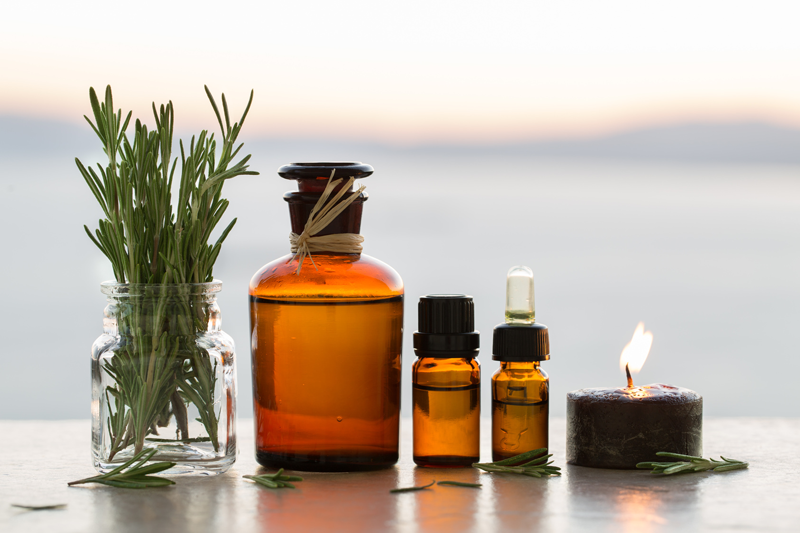Here’s something I want you to know: most chronic diseases – those conditions that always wreck our lives and sometimes even kill us – are preventable (1).
That means with the seemingly small decisions you make each day, you are paving your path toward health or toward disease. One of the biggest factors in that journey is chronic inflammation, and I want to show you how using essential oils for inflammation is one of those seemingly small decisions that leads you in the right direction.
But first, I want to first make sure you understand what inflammation really is.
TRUTH BOMB:
You’re
Already killing it!
If You Were More Consistent With Your Wellness Routine, You’d Be Unstoppable.
Inflammation is your body’s self-defense system against any sort of injury, infection or threat. In the right situations, inflammation can literally save your life.
But inflammation often goes haywire. Let me explain. There are two types of inflammation:
- Acute inflammation – like the redness and swelling after you get a splinter or the runny nose you get when your body’s fighting off a bug – is good, healthy, and necessary. Acute inflammation is short-term and remains under control.
- Chronic inflammation, on the other hand, is long-term and out of control. It’s systemic. It can destroy your tissues and lead to chronic diseases and oxidative damage.
Chronic inflammation is one of the root causes of chronic illness.
It plays a part in all the destruction your body can experience. It leads to inflammatory conditions like arthritis, asthma, Crohn’s disease, and many more. There’s even a strong connection between chronic inflammatory conditions and damage in the brain, heart, arteries, etc., which leads to diseases like cancer, diabetes, heart disease, osteoporosis, kidney failure, respiratory diseases, depression, etc. (1, 2).
Essential oils for inflammation are going to help you deal with both acute and chronic inflammation. Not only will they help you feel better in the here and now (like lessening joint pain), they will help keep your body healthy over the long haul (like calming chronic, internal inflammation).
Different Causes of Inflammation
The causes of acute inflammation are often obvious – the knife that cut your finger, the flu bug that gave you the congested nose, the fall that made your knee swell up.
But the causes of chronic, systemic inflammation are not always so obvious. In order to know how to get rid of this dangerous type of inflammation, we have to know where it comes from. Here are a few common causes and contributors to chronic inflammation:
-
Poor Nutrition
This is one of the #1 factors of inflammation. Most people in the 21st century are consuming so many inflammatory foods and they’re not eating enough anti-inflammatory foods. Sugar, salt, omega-6 fatty acids, hydrogenated oils – these ever-so-common ingredients highly prevalent in processed foods are inflaming your body (3).
-
Stress
I know you’ve been told countless times how stress harms your body, but here’s one more. The hormones your body gives off when you are under continual stress lead to chronic inflammation. When you’re not sleeping well (thanks to that racing mind, worry, depression, etc.), your chances of increasing inflammation goes up too.
Plus, science has shown us that when you’re constantly in a state of stress, your body may actually lose its ability to regulate inflammation (3).
-
Sedentary Lifestyle
One study of over 900 participants found that people who spend most of the time sitting at work have worse inflammatory markers than those who perform some sort of physical activity. None of this is surprising – we know that a sedentary lifestyle is the gateway to chronic disease (4). On the flipside, constant overtraining can leave you with chronic inflammation too. The goal should be an active life without falling toward one extreme or the other.
-
Environmental Toxins and Smoking
When you are breathing in toxic chemicals or putting them on your skin, you are increasing your body’s inflammatory response. After all, these are harmful irritants, and it’s your body’s job to get rid of them. The problem here is a house filled with toxic cleaning products, personal care products, makeup and more is creating low, yet consistent exposure – a recipe for aggravated chronic inflammation (3).
Smoking is one of the worst environmental toxins, and it is directly connected to chronic inflammation (5).
Why Use Natural Solutions for Inflammation
Now let’s focus on what you can do about all of this. The first thing you can do is stop exposing yourself to toxins and foods that create inflammation in the body. So, this means if your diet is full of inflammatory foods, it’s time to stop eating them. If you’re dealing with stress all the time, it’s time to create space in your life so that you can relax and unwind on a regular basis. If you’re living a sedentary lifestyle, it’s time to get active! And if you already know that you’re exposed to too many toxins in your home then work on removing these products/exposures and replace them with natural, non-toxic alternatives.
Seem like an overhaul? Well, it is! And it’s a big reason why we created elevays.com. We want to help you create an environment that allows you to be your best, functioning at your highest level and preventing disease the whole way. Removing the multiple sources of inflammatory exposure is the first place to start for eradicating systemic inflammation. Nothing – including essential oils – will be as powerful as starting here first.
Now, you may be wondering, “But what about medications? Aren’t there medicines I can take to reduce inflammation?”
The conventional treatments for inflammation – both acute and chronic – are typically some sort of prescription or over-the-counter anti-inflammatories. NSAIDs (nonsteroidal anti-inflammatory drugs), like ibuprofen, and corticosteroids are common.
But there are issues with anti-inflammatory medications, especially when you’re using them long-term.
NSAIDs can be a factor in leaky gut (3). Even the FDA warns that NSAIDs can increase your risk of both stroke and heart disease (6). Corticosteroids have plenty of problems too including increased risk of glaucoma, hypertension, weight gain, mood problems, psychological problems, fluid retention, etc.
Here’s the amazing thing: dealing with both acute and chronic inflammation naturally is not complicated, and it’s highly effective (7). Some of the top choices you will need to make are:
- Adopt an anti-inflammatory diet: Fruits, veggies, fish, nuts, and seeds are your friends; sugar, processed food, and hydrogenated/trans fats are your enemy.
- Move your body: Get into a regular moderate exercise regimen; do something each day that gets your body moving.
- Manage your stress: See a therapist, delegate some tasks, diffuse some relaxing essential oils – do whatever you need to in order to drop those cortisol levels
- See a physical therapist: A physical therapist can help you get rid of acute inflammation problems and manage chronic inflammation problems – especially if you are dealing with arthritis.
And then – we finally circle back around to our essential oils for inflammation.
Best Essential Oils for Inflammation
If you want to know how to use essential oils for inflammation, I have 8 of the top choices for you.
Keep this in mind, the ideal essential oil for inflammation is ultimately going to be a blend – a combo that allows multiple oils to utilize their strengths at one time. But it’s important for you to understand what each oil offers individually first.
You will find that these essential oils for inflammation have a wide variety of purposes. Some do a great job at limiting the aches and pains you would often grab an over-the-counter anti-inflammatory to ease. Some are anti-inflammatory essential oils for skin care. Some deal with digestive problems. Others are focused on soothing overall, chronic inflammation.
Read on to see how you can support healing inflammation with essential oils:
-
Wintergreen
First up we have the sweet and minty wintergreen. It is definitely one of the top essential oils for joint pain and inflammation in particular.
Wintergreen acts like an analgesic, and it does it so well people have called it “liquid aspirin.” Turns out, the name is appropriate. One study found that the chief ingredient in wintergreen – which is called methyl salicylate – is closely related to something called acetylsalicylic acid, AKA: aspirin (8).
Researchers found the ideal combo was wintergreen and peppermint, which just so happens to be next up on our list of essential oils for inflammation (9).
-
Peppermint
Our next essential oil for inflammation is amazing – one of the most versatile, helpful oils in the world.
Peppermint essential oil is great for relieving all sorts of side effects that spring up from both acute and chronic inflammation – making it one of the best essential oils for internal inflammation.
Peppermint essential oil is right up there with lavender in terms of versatility, so it can (10, 11):
- Relieve nasal congestion/cough from your common cold
- Aid in asthma symptoms
- Reduce muscle/joint pain or cramps
- Alleviate headaches
- Improve tendonitis
- Decrease bruising
- Boost energy
- Stop digestive problems
- Improve allergies
- Lower stress
- And more
If you could only afford one essential oil for inflammation to get as much done as possible – peppermint may be your best bet.
-
Birch
This is one of the lesser known essential oils, so I’d like to bring it to your attention. Birch oil actually has the exact same active ingredient as wintergreen, methyl salicylate, the one that behaves quite similarly to aspirin. In fact, they are the only two plants in existence that contain this helpful substance naturally (12).
This means birch is another one of those amazing essential oils for joint pain and inflammation.
Now keep this in mind: birch is a really strong, concentrated oil, so it’s not ever really used on its own. It is often included with other essential oils for inflammation and then heavily diluted with a carrier oil (13). For an example, you’ll see how you can use birch in the section on essential oils for arthritis recipes.
-
Cypress
Up next is cypress essential oil. This is a real woody, yet clean smelling oil that I love to use as an energy booster. But it’s also a great topical anti-inflammatory choice.
Cypress has been shown to improve inflammatory symptoms and conditions including swelling, pain, tendonitis, and asthma. It’s known for being a great natural solution to carpal tunnel. It also decreases the swelling and general inflammation of the wrist (10, 11).
Cypress is also a fabulous respiratory support. When inflammation wreaks havoc in your lungs/airways through asthma or bronchitis, cypress can help support airway function.
But what interests me the most about cypress is its detoxing benefits. It’s a powerful antioxidant. It helps the body flush out any buildup you don’t want to be there. This is why I consider it one of the best essential oils for internal inflammation (14).
-
Rosemary
Our next essential oil for inflammation has been highly studied, so we can see multiple ways rosemary combats inflammation (15).
- One study gave patients with osteoarthritis, rheumatoid arthritis, and fibromyalgia rosemary extract for 4 weeks. At the end of the trial, inflammation had “noticeably” decreased, as did pain.
- Other studies have shown that rosemary is incredibly effective and protecting against gastric ulcers caused by inflammation.
- Another study on mice showed it was a fabulous topical anti-inflammatory.
Rosemary also helps your body lower its cortisol levels, an essential component of keeping chronic inflammation away (16).
-
Frankincense
For centuries, frankincense was used as a way to deal with inflammatory diseases. This is one of the reasons it was considered so very precious (one of the gifts given to the baby Jesus in the Bible). In today’s world, modern science has shown us we should still think of frankincense as a precious oil – it is one of the top essential oils for inflammation.
Like the other essential oils for internal inflammation, frankincense studies have shown this oil can actually repress the formation of inflammatory markers (17, 18). Time and time again it’s been shown to aid inflammatory arthritis conditions (19). One study even showed a hand massage with frankincense oil on patients with cancer greatly reduced their pain (20).
Finally, frankincense also helps with digestive inflammation. It is a wonderful tonic for any sort of digestive disorder (19).
-
Lemongrass
When many people start out on their essential oil journey, lemon oil is one of the first to come along – as it should be, it’s versatile and wonderful. Lemongrass, on the other hand, often gets forgotten, and that’s a shame. It’s a powerful helper to the digestive system and great for heightening focus and positivity.
Lemongrass is also great for calming inflammation.
One study aimed to see how lemongrass essential oil could affect inflammatory markers within the body. The results showed lemongrass could “significantly” inhibit the production of all sorts of these markers – even to the point of improving gene expression and signaling pathways (21).
Though these results are encouraging for inflammation in particular, making it one of top essential oils for internal inflammation, it has proven to be particularly helpful for inflammatory skin conditions.
If you have any sort of skin inflammation, or dermatitis, lemongrass may be ideal for you. Add a drop to a nourishing carrier oil like Almond Oil to make a non-medicated, yet therapeutic skin rub.
-
Helichrysum
Last on our list of essential oils for inflammation is one of my absolute favorites. Helichrysum is a flower, and the oil has a sweetness that’s honey-like, but it’s also quite herbaceous.
This essential oil for inflammation has been studied by scientists both in-vivo and in-vitro with similar results: it is an anti-inflammatory and an antioxidant. How does it work? Helichrysum can (21, 22, 23):
- Inhibit inflammatory enzymes
- Inhibit free-radical scavenging
- Behave similarly to a corticosteroid
Arguably one of the most important anti-inflammatory qualities of helichrysum is its ability to battle gut inflammation. Keep in mind the majority of your immune system is in the gut – when you’re having gut issues, your whole body is going to have issues (22).
How to Use Essential Oils for Inflammation
While diffusing essential oils for their aromatherapy benefits is normally one of my go-to methods for most ailments, I prefer to focus on topical and internal methods when it comes to healing inflammation with essential oils. Here’s how to use essential oils for inflammation:
Take Them Internally
Let’s be super clear: not all essential oils should be ingested – and certainly not all brands have high enough quality for you to ingest their oils. However, if you choose high-quality, food-grade oils (like doTERRA essential oils for inflammation), these can become ideal essential oils for internal inflammation.
Here are the oils from our list of essential oils for inflammation you can take diluted in 4 ounces of liquid (1 to 2 drops). You can also take these in a veggie capsule. Add 1 to 2 drops to the capsule and fill the rest with a cooking oil, like extra virgin olive oil.
- Peppermint
- Lemongrass
- Helichrysum
- Rosemary
- Frankincense
Keep in mind that you don’t want to be taking essential oils internally forever. You can become sensitized to oils that way and we don’t want that. It’s important to cycle on and off of these oils as you are clearing things from your life that are making the chronic inflammation worse. Personally, I would be on the oils for 2 weeks and then off for 2 weeks. After 3 months I’d evaluate to check on progress.
Use Them Topically
This is one of the best choices – especially when it comes to essential oils for joint pain and inflammation. It couldn’t be simpler.
Choose a couple of the essential oils for inflammation that you feel best address your particular concerns. Dilute them with a carrier oil of your choice (almond oil, coconut, or jojoba oils are great choices), and you’re good to go.
You can add them to a rollerball for convenience.
Now, I realize figuring out how to combine your essential oils for inflammation can sometimes feel a bit overwhelming – how much of what kind? So I have a few examples. Many people dealing with inflammation are dealing with pain in their joints, so let’s start there.
Here are three essential oils for arthritis recipes to get you started.
Essential Oils for Arthritis Recipes
Essential Oil Blend for Rheumatoid Arthritis (from Wendy Polisi)
- 2 drops peppermint essential oil
- 2 drops wintergreen essential oil
- 2 drops frankincense essential oil
- 2 drops eucalyptus essential oil
- 2 drops cypress essential oil
Dilute in a carrier oil and apply to the area as needed.
Essential Oil Blend for Arthritis Pain (from Enjoy Natural Health)
- 5 drops rosemary essential oil
- 5 drops birch essential oil
- 5 drops eucalyptus oil
- 3 drops peppermint oil
- 10 drops lavender oil
Top off the rest of the rollerball with a carrier oil
Magnesium Bath Soak (from Holistic Squid)
- 3 cups Epsom salts
- 1 tablespoon carrier oil
- 5 drops wintergreen essential oil
- 5 drops rosemary essential oil
- 5 drops peppermint essential oil
Purchase a Blend: doTERRA essential oils for inflammation
One of the easiest ways to benefit from the essential oils for inflammation is to simply buy blends from a reputable company.
Some of my favorite doTERRA essential oils for inflammation are joined together in one blend: Deep Blue.
This combo includes wintergreen, peppermint, helichrysum, and more to both soothe and cool inflamed areas, particularly joints and muscles. They even offer it in a roll-on for convenience.
Healing Inflammation with Essential Oils
I want this information on essential oils for inflammation to bring you hope that there are perfectly safe, all-natural remedies that will decrease inflammation and help you feel less pain.
Whether your pain, swelling, stiffness, etc. comes from acute or chronic inflammation, I know you want to feel less of it. The essential oils for joint pain and inflammation can be a significant help to you.
I also want you to remember that using these essential oils for internal inflammation may seem like insignificant choices when it comes to something as large as the impact of chronic inflammation. But when you combine small choices with other small choices, like diet and exercise, real change can begin.
I’d love to hear what you have to say about healing inflammation with essential oils. What all-natural solutions have you tried to help inflammation? Have they helped? Which of these essential oils for inflammation do you love or can’t wait to try? Leave a comment below to share your thoughts with our community.
Sources:
- Prasad, S., & Aggarwal, B. B. (2014). Chronic diseases caused by chronic inflammation require chronic treatment: anti-inflammatory role of dietary spices. J. Clin. Cell. Immunol, 5(238), 10-4172.
- PubMed Health, (2015). What is an inflammation?
Retrieved from: https://www.ncbi.nlm.nih.gov/pubmedhealth/PMH0072482/ - Arizona Medical Center for Advanced Medicine, (2013). Inflammation: A Common Denominator of Disease. Retrieved from: http://www.arizonaadvancedmedicine.com/Articles/2013/June/Inflammation-A-Common-Denominator-of-Disease.aspx
- León-Latre M, Moreno-Franco B, Andrés-Esteban EM, Ledesma M, Laclaustra M, Alcalde V, Peñalvo JL, Ordovás JM, Casasnovas JA (2014) Sedentary lifestyle and its relation to cardiovascular risk factors, insulin resistance and inflammatory profile. Rev Esp Cardiol (Engl Ed). 2014 Jun;67(6):449-55. Retrieved from: https://www.ncbi.nlm.nih.gov/pubmed/24863593
- Lee, J., Taneja, V., & Vassallo, R. (2012). Cigarette Smoking and Inflammation: Cellular and Molecular Mechanisms. Journal of Dental Research, 91(2), 142–149. http://doi.org/10.1177/0022034511421200
- Curfman, Gregory (2015). FDA strengths warning that NSAIDS increase heart attack and stroke risk. Harvard Health Publishing. Retrieved from: https://www.health.harvard.edu/blog/fda-strengthens-warning-that-nsaids-increase-heart-attack-and-stroke-risk-201507138138
- Mayo Clinic (2015). Prednisone and other corticosteroids. Retrieved from: https://www.mayoclinic.org/steroids/art-20045692?pg=2
- Hebert, P. R., Barice, E. J., & Hennekens, C. H. (2014). Treatment of Low Back Pain: The Potential Clinical and Public Health Benefits of Topical Herbal Remedies.
- Dr. Eric Z., (2018). Essential Oils for Arthritis, Pain, Inflammation & More! Retrieved from: https://drericz.com/essential-oils-for-arthritis/
- Dr. Axe, (2018). 6 Natural Treatments for Tendonitis. Retrieved from: https://draxe.com/tendonitis/
- Dr. Axe, (2018). 7 Natural Sprained Ankle Treatments to Get You Back on Your Feet Again. Retrieved from: https://draxe.com/sprained-ankle-treatments
- doTERRA (2018) Wintergreen. Retrieved from: https://www.doterra.com/US/en/p/wintergreen-oil
- Bright, Sierra (2016) 10 Essential Oils That Can Seriously Releive Arthritis. Natural Living Ideas. Retrieved from: http://www.naturallivingideas.com/essential-oils-for-arthritis/
- Dr. Axe (2018). 8 Surprising Benefits of Cypress Essential Oil. Retreived from: https://draxe.com/cypress-essential-oil/
- Ghasemian, M., Owlia, S., & Owlia, M. B. (2016). Review of Anti-Inflammatory Herbal Medicines. Advances in Pharmacological Sciences, 2016, 9130979. http://doi.org/10.1155/2016/9130979
- Dr. Axe (2018) Rosemary Oil Uses and Benefits. Retrieved from: https://draxe.com/rosemary-oil-uses-benefits/
- Abdel-Tawab M, Werz O, Schubert-Zsilavecz M. Boswellia serrata: an overall assessment of in vitro, preclinical, pharmacokinetic and clinical data. Clin Pharmacokinet. 2011;50:349–369.
- Triantafyllidi, A., Xanthos, T., Papalois, A., & Triantafillidis, J. K. (2015). Herbal and plant therapy in patients with inflammatory bowel disease. Annals of gastroenterology: quarterly publication of the Hellenic Society of Gastroenterology, 28(2), 210.
- Mercola (2016). Frankinecanse Oil: The ‘King of Oils’ Retreived from: https://articles.mercola.com/herbal-oils/frankincense-oil.aspx
- Chang, S. Y. (2008). Effects of aroma hand massage on pain, state anxiety and depression in hospice patients with terminal cancer. Journal of Korean Academy of Nursing, 38(4), 493-502.
- Sala A1, Recio M, Giner RM, Máñez S, Tournier H, Schinella G, Ríos JL. (2002) Anti-inflammatory and antioxidant properties of Helichrusum italicum. J Pharm Pharmacol. Mar;54(3):365-71. Retrieved from: https://www.ncbi.nlm.nih.gov/pubmed/11902802
- Dr. Axe (2018) Helichrysum Essentail Oil: Uses, Benefits & DIY Recipes https://draxe.com/helichrysum-essential-oil/
- doTERRA (2018) Helichrysum Oil. Retrieved from: https://www.doterra.com/US/en/p/helichrysum-oil










Thank you for sharing this! This article is exactly what I was looking for. After so many cortisone injections into my shoulder, the inflammation in the joint still persists. Nothing seems to help and the doctor is clueless as to why my shoulder is inflamed and hence, frozen in place. I can’t wait to try out the oils you mentioned.
Hi Kerstin! We are SO glad you found this helpful! Hoping your shoulder feels better soon 🙂
Where do I purchase that oils
Hi Jocelyn,
Thanks for your message! You can check out one of our starter kits or sample kits here: https://store.elevays.com/collections/essential-oils. I will also follow up via email to get a better feel for what you need and make any recommendations based on that. 🙂
Sincerely,
Erica
Thank you for sharing that detail. It was fascinating and insightful. Continue to share useful resources over these blogs…
I’m so glad it was helpful for you!
This is very helpful. Thanks. God bless you
Good information. I have adhesions and looking for a good “recipe “. I was thinking lemongrass and peppermint combo.
What is your goal with using essential oils for your adhesions? Are these skin scar tissue or internal? The best essential oils for skin and cellular repair are frankincense and lavender. Especially that combo together! Lemongrass (while good for skin on some occasions) and peppermint (mainly good for headaches and belly aches when applied topically) would not be my first choices for adhesions. Check out these articles for more info on frankincense and lavender. https://elevays.com/benefits-of-frankincense-essential-oil/ and https://elevays.com/benefits-of-lavender-essential-oil/ hope this helped!!